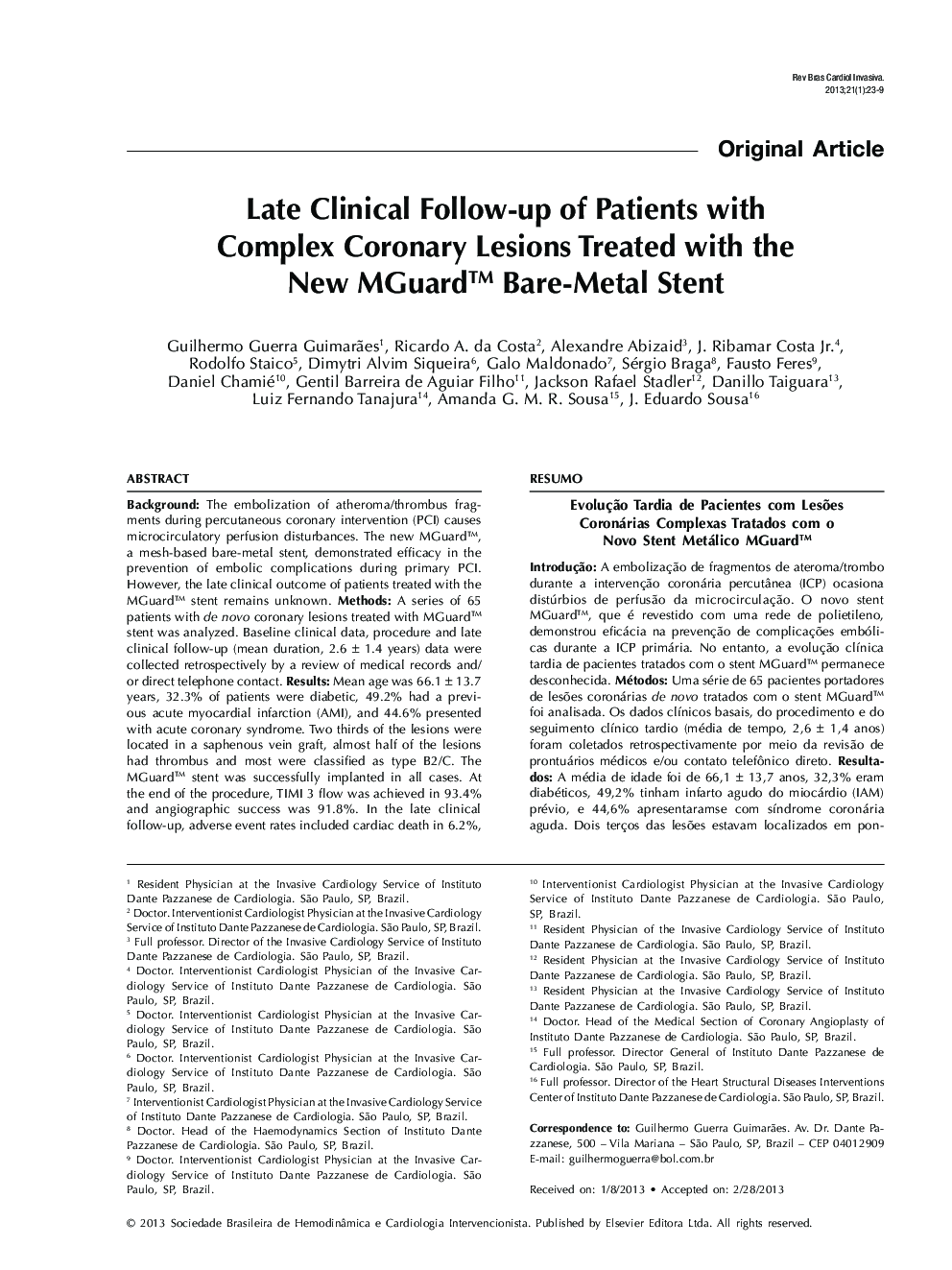| Article ID | Journal | Published Year | Pages | File Type |
|---|---|---|---|---|
| 3011710 | Revista Brasileira de Cardiologia Invasiva (English Edition) | 2013 | 7 Pages |
ABSTRACTBackgroundThe embolization of atheroma/thrombus fragments during percutaneous coronary intervention (PCI) causes microcirculatory perfusion disturbances. The new MGuard™, a mesh-based bare-metal stent, demonstrated efficacy in the prevention of embolic complications during primary PCI. However, the late clinical outcome of patients treated with the MGuard™ stent remains unknown.MethodsA series of 65 patients with de novo coronary lesions treated with MGuard™ stent was analyzed. Baseline clinical data, procedure and late clinical follow-up (mean duration, 2.6 ± 1.4 years) data were collected retrospectively by a review of medical records and/ or direct telephone contact.ResultsMean age was 66.1 ± 13.7 years, 32.3% of patients were diabetic, 49.2% had a previous acute myocardial infarction (AMI), and 44.6% presented with acute coronary syndrome. Two thirds of the lesions were located in a saphenous vein graft, almost half of the lesions had thrombus and most were classified as type B2/C. The MGuard™ stent was successfully implanted in all cases. At the end of the procedure, TIMI 3 flow was achieved in 93.4% and angiographic success was 91.8%. In the late clinical follow- up, adverse event rates included cardiac death in 6.2%, nonfatal AMI in 9.2%, target lesion revascularization in 9.2% and definite/probable stent thrombosis in 1.5%.ConclusionsThe late follow-up of patients with complex coronary lesions treated with the MGuard™ stent demonstrated low rates of target lesion revascularization and stent thrombosis.
RESUMOEvolução Tardia de Pacientes com Lesões Coronárias ComplexasTratados com o Novo Stent Metálico MGuard™IntroduçãoA embolização de fragmentos de ateroma/trombo durante a intervenção coronária percutânea (ICP) ocasiona distúrbios de perfusão da microcirculação. O novo stent MGuard™, que é revestido com uma rede de polietileno, demonstrou eficácia na prevenção de complicações embólicas durante a ICP primária. No entanto, a evolução clínica tardia de pacientes tratados com o stent MGuard™ permanece desconhecida.MétodosUma série de 65 pacientes portadores de lesões coronárias de novo tratados com o stent MGuard™ foi analisada. Os dados clínicos basais, do procedimento e do seguimento clínico tardio (média de tempo, 2,6 ± 1,4 anos) foram coletados retrospectivamente por meio da revisão de prontuários médicos e/ou contato telefônico direto.ResultadosA média de idade foi de 66,1 ± 13,7 anos, 32,3% eram diabéticos, 49,2% tinham infarto agudo do miocárdio (IAM) prévio, e 44,6% apresentaramse com síndrome coronária aguda. Dois terços das lesões estavam localizados em pontes de safena, quase metade tinha presença de trombo e a maioria foi classificada como tipo B2/C. O stent MGuard™ foi implantado com sucesso em todos os casos. Ao final do procedimento, fluxo TIMI 3 foi alcançado em 93,4% e o sucesso angiográfico foi de 91,8%. No seguimento tardio, as taxas de eventos adversos incluíram óbito cardiovascular em 6,2%, IAM não-fatal em 9,2%, revascularização da lesãoalvo em 9,2% e trombose de stent definitiva/provável em 1,5%.ConclusõesO seguimento tardio de pacientes com lesões coronárias complexas tratados com o stent MGuard™ demonstrou baixas taxas de revascularização da lesãoalvo e de trombose do stent.
